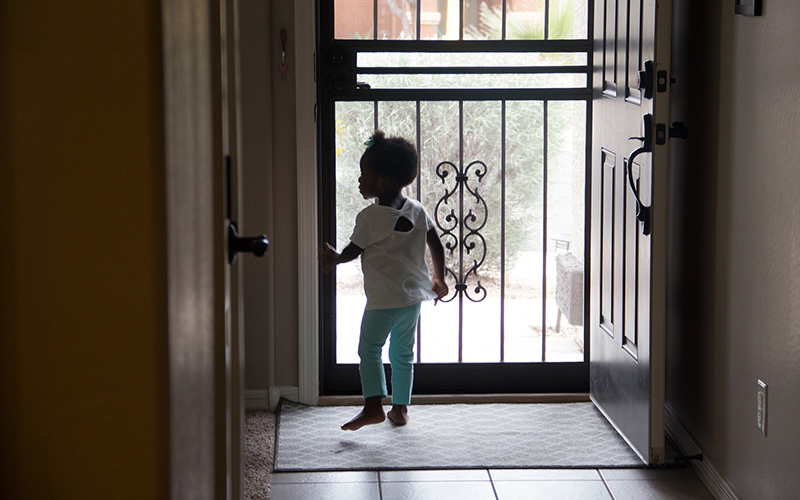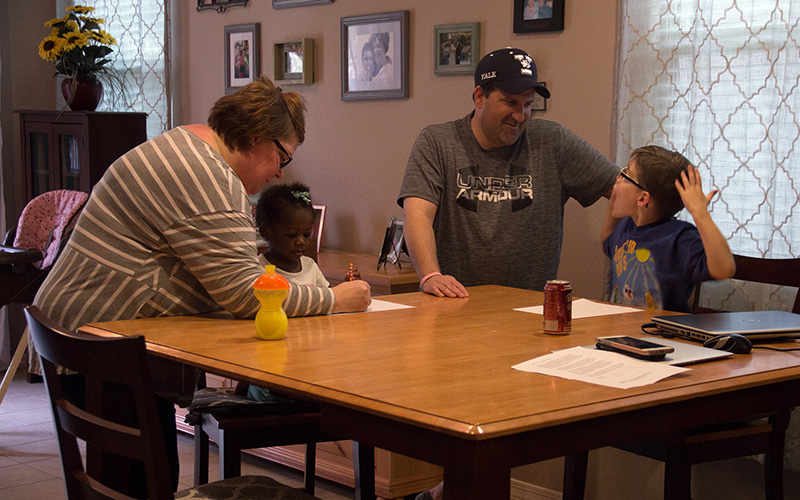
Two-year-old Katie Medved is now walking, which makes safety an even bigger priority for her parents. The Medveds fostered Katie from birth and later adopted her. (Photo by Lily Altavena/Cronkite News)

Michelle Medved shows off part of her family’s first-aid kit, a safety requirement from the Arizona Department of Child Safety. (Photo by Lily Altavena/Cronkite News)
WADDELL – Before welcoming a newborn into their home, Michelle and Scott Medved prepared as many parents would. They installed magnetic locks on their cabinets, put together a detailed first aid kit and carefully plotted out an evacuation plan, marking the exits in each room in their home.
But after all that, the Medveds did something most new parents don’t: they waited for a state inspector to give them the go-ahead. The Medveds were navigating the complex state safety requirements that stood between them and Katie, the drug-dependent baby girl they wanted to bring into their foster home.
“It kind of teaches us: Shouldn’t we be doing this with all of our children?” Michelle Medved said of the licensing process.
In January of 2016, Arizona’s Department of Child Safety revised its rules for life safety inspections. With the new administrative code – which includes more detail about animals, firearms and other safety precautions – inspection deficiencies “skyrocketed,” said DCS life safety inspections unit manager Thea Bish.
The agency had never tracked specific deficiencies, but started in the middle of last year after it noticed a spike. From April to December of 2016, DCS tracked 3,310 inspections – 1,914 of those inspections resulted in a deficiency.
To some families and organizations, the new regulations are onerous additions to a lengthy licensing process. From a DCS perspective, the rules are a necessary precaution in protecting some of the state’s most vulnerable children.
When asked what she would tell families who feel that the rules are cumbersome, Bish said, “I would say that we’re looking at the overall safety of a child so, you know, the rules, while it might seem cumbersome, are not necessarily unrealistic… If you’re doing regular foster care, you might not know what that child has been exposed to, what their behaviors are, what their history is – we want to make sure that they’re going into a safe environment.”
Bahney Dedolph, a policy analyst with the Arizona Council of Human Service Providers, said the problem lies in an “overly rigid implementation of the rules.” Though she says the state has improved, she believes inspectors are not enforcing the “spirit” of the new rules, instead focusing on trivial details that prolong the licensing process for prospective foster parents.
Dedolph’s organization, which she said was involved in creating the new rules, conducted a survey in February and September of 2016, asking 307 foster parents and parents in the licensing stage what they thought about the impact of the changes. In September, 50 percent answered that they had problems with the new rules, 21 percent said they thought the expansion was an improvement from the old system and 29 percent reported no change.
One parent wrote in the survey, “Inspections have been inconsistent and a bit of overkill.”
Initially after the rule change, Bish said there was an increased queue of about 1,200 prospective foster homes waiting for life safety inspections– but her office has worked to reduce that number to about 400. It also recently added a fifth life safety inspector.
Licensing agencies, in a similar survey, worried that a more overwrought process would deter families from opening up their homes when those beds are desperately needed. From April of 2016 to September of 2016, 994 foster homes closed while 985 new homes opened. In the same period in 2015, 767 closed while 774 opened, according to a DCS semi-annual report on child welfare.
Annette Haffner, a foster parent for the past two and a half years, said the change cost her $1,000 to make modifications to pool fencing. Haffner was in the process of adopting their first foster daughter, who is now 3 years old and struggled with drug dependency.
“Are they making so many barriers for us that we’re not able to parent them in normal ways?” she said. “The process to get licensed is extremely frustrating.”

The Medved family colors at the kitchen table. From left: Michelle Medved, Katie Medved, Scott Medved and Matthew Medved. (Photo by Lily Altavena/Cronkite News)
Scott and Michelle Medved have gone through two state inspections. The parents, who also have a 7-year-old biological son named Matthew, decided to become foster parents after their daughter died of Sudden Infant Death Syndrome at 10 weeks old. They fostered and eventually adopted 2-year-old Katie and an 18-month-old son.
Katie is walking, making safety an even bigger priority.
“Just being so mobile, being aware of the locks in the house, the cabinets, where we have little catches for – she can figure out how to open those,” Scott Medved said.
Though the inspection is conducted by a state employee, much of the preparation for the process is facilitated by a foster family’s licensing agency. The Medveds went through Aid to Adoption of Special Kids (AASK), which helped them unravel some of the more-involved regulations, such as buying the right type of fire extinguisher – one with “a rating of 2A 10BC or greater” – or posting detailed evacuation plans.
Michelle Medved remembers the first inspection as “a positive experience.” But the second inspector opened every drawer and cupboard, she said, and told them they needed to dismantle their first aid kit, separating each item out.
“There were things that you didn’t think about and you had to say, ‘oh, now what do I do?'” she said.
Jamie Lindsey works with families to avoid those moments of confusion. Lindsey is an initial license specialist with Child Crisis Arizona, another foster home licensing agency.
“There’s just a ton of information that the family needs to know,” she said. “You have to look at everything possible. Open every door. Which is kind of intrusive for families and not always the most comfortable for us.”
The process becomes a dance between the state, the family and the licensing agency. Bish said DCS has been trying to improve its communication with licensing agencies, such as creating a guide for families and sending a list of the top five reasons families fail every month.
Every home presents different issues, according to Lindsey. Older homes typically found in Downtown Phoenix can have more problems than newer ones – such as a window with a small crack. And in the Phoenix area, where 42.8 percent of homes have a pool, according to a U.S. Census American Housing Survey, fences surrounding the pool need to be a certain height.
“It’s really hard to pass the first one with a pool,” Lindsey said.
Bish said DCS’ Office of Licensing and Regulation also encourages inspectors to do what they can to help families.
“Our team really tries to help and assist in any ways that we are physically able to during the inspections to help them pass,” she said. “I can go through a whole gamut of things that we’ve done: you know, help grade yards, move gravel to get the height of the pool fence up, installed smoke detectors, moved door handles, installed magnet locks.”
The Medveds said the experience has made them more conscious of the risks in their home.
“It also made us more aware of what we needed to prepare and things we never thought about in terms of getting our home set up,” Scott Medved said.